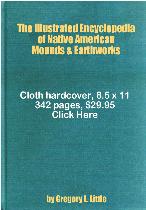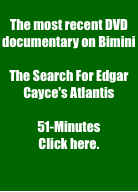 | ||||
 | ||||
The Illustrated Encyclopedia of Native American Mounds & Earthworks — by Dr. Greg Little | ||
A.R.E.'s Search for Atlantis Project—June 2003 Andros-Bimini Update by Dr. Greg Little We returned to Andros Island on June 16 to investigate another possible underwater area that reportedly had a stone formation similar to the previously reported Stone Platform. In addition, we had planned on meeting a production crew at Andros, which was filming an Atlantis Search documentary for The Learning Channel. Upon our arrival at Andros a phone call informed us that the crew wanted us to immediately go to Bimini. They couldn't get to Andros for several reasons, but were immediately heading to Bimini from Miami in a research boat. It simply wasn't feasible or desirable for us to immediately leave Andros, so we remained on Andros for 2 days. During this time we interviewed Dino Keller, the former dive operator who had initially informed us about the underwater formation. While on Andros we also looked at several underwater sites. More Areas We discovered another area of gigantic, smooth stones not far from the original site. This area was huge and was not formed in levels or tiers. It was at the same depth as the original site (10 feet) and was at least 100 yards by 100 yards, forming a massive, flat platform. Basically, this area is several hundred yards from the original site and was, no doubt, related to it. We also looked at the original site and viewed areas we had not previously seen. We found this surprising since we thought we had seen most of it on earlier expeditions. All of these new areas of the platform were quite impressive and showed the three tiers comprised of 2-foot thick stones, most of which were 25 by 30 feet. Looking at the Seams The seams between the stones are filled with sand, seaweed, and rubble. This tends to make the seams easily visible, but it also seemed to show that some of the seams were not straight and at right angles. Initially we had planned on cleaning out several seams to investigate this, but the early departure from Andros and a massive tidal flow prohibited this. Instead, we chose to clean a small area where three stones came together in roughly a "T" formation. The goals were to view the sides of some of the smaller stones, get an idea of the width of the seams, investigate the thickness of the stones on the inner portion of each platform (where the stones were smaller than the 25 by 30 feet), and to see if these seems were straight. An area where three stones came together was chosen. Prior to brushing away the sand and rubble in the seams, the seams between these three stones looked crooked. However, after an exhaustive 20-minute period of brushing and removing smaller stones and rubble from the one-to-two inch wide seams, it was apparent that the seams were perfectly straight and deep. The seams were cleared to a depth of 5-7 inches and it was obvious that the adjoining stones were solid and much thicker. An extremely strong tidal flow made this work difficult. Basically, Greg had to use one hand to hold on to the bottom by wedging fingers into the seam while brushing and working with the other hand. Lora videotaped the work from the surface, but she had to constantly keep moving into the strong tidal flow to maintain her position. In brief, what we viewed on this trip to Andros looked manmade. The stones which have some sand on them seem extremely well-preserved and it seems obvious that the seams between them are not cracks. There is so much regularity in the structure that the leap to it being manmade isn't at all difficult. The reason that some of the seams looked "crooked" became apparent as the work proceeded on cleaning out several seams. At the very top of some seams, small stones or debris had fallen into them protruding from them. Sand would build up on the sides of this debris and seaweed soon rooted on the building sand. Then more sand would accumulate on the stable area of the protrusion gradually moving out from the seam in a haphazard manner. When some of these seams were viewed from the surface, it sometimes looked like a wavy line of seaweed. Bimini At Bimini we met the production crew and David Hatcher Childress, founder of the World Explorers Club and author of some of the most intriguing travel books ever written. The production crew was filming two documentaries and David was the prime person involved in their Bermuda Triangle documentary. Greg scuba dived the Bimini Road with David for two hours, filming David the entire time for the documentary. In addition, David measured the area for electromagnetic anomalies using a meter Greg brought along. (Both of these TLC documentaries are scheduled for showing in January 2004.) Two areas of Bimini were investigated for the Atlantis documentary. The first area was at South Bimini where we tried and failed to find the 200-foot circle initially discovered in the A.R.E.'s satellite imaging project. The 55-foot research boat brought to Bimini from Miami went to the GPS coordinates identified as the location, but the circle wasn't within sight. A high lookout on the boat, at least 45 feet above the water's surface, enabled us to search the surrounding area, but nothing remotely resembling the circle was in the vicinity. We had previously encountered this problem but it was then attributed it to faulty GPS readings. The problem now appears to be due to a glitch in the computer program generating the GPS from the satellite images. Before going to Bimini we had anticipated this problem and formed a dead-reckoning course to the circle similar to methods employed by pilots flying under visual flight rules. The boat however, was too big to go into the shallow waters to follow the course. Investigating the Straight Lines Found in the A.R.E.'s Satellite Project The next day, we went to the area of the straight lines discovered in the satellite project, but we had an additional boat. We had previously contracted with a smaller dive boat to take us to several locations, so both boats were utilized. At this site, located at NE Bimini, a host of interviews and other activities were filmed. We then snorkeled the area and looked at many of the lines. These all turned out to be simple formations of sand channels and seaweed made by consistent water movements. The dive operators were quite familiar with the lines. The Discovery of the 200-Foot Circle At 3:00 pm, the larger boat departed for Miami and we immediately went back to South Bimini to search for the circle in the smaller boat. Following the dead-reckoning course we had made, we landed right on top of the circle within 10 minutes. The circle is elevated at least 5-feet off the bottom and has well-defined, vertical sides—just as we had surmised from aerial views of it. It resembles a mound, but has a well-defined rectangular formation on the southern side of it. It also has two large depressions within it which also have vertical sides. This is a highy curious finding. The next morning we closely inspected and videotaped the circle while scuba diving it. Two quite interesting stone objects were removed from it, one of which was reddish in color and found about four feet down an outer wall. It looked somewhat like a very old brick but was much smaller than any known historical bricks. The other stone was found about a foot inside the bottom of one of the vertical walls forming one of the depressions inside the circle. That stone may be granite and looks somewhat like a piece of a rectangular building block. Both of these are now being geologically tested. Our working hypothesis about the circle was that it had been formed by a crashed plane. That certainly does not appear to be the case. Some type of structure seems to lie under this intriguing feature. But the discovery of the reddish, brick-like stone makes the probable age of this structure fairly recent. Summary In brief, the underwater platform at Andros looks more and more manmade every time we investigate it. This is not because of wishful thinking, because both Lora and I have had nagging suspicions that it is an ancient beach. But the three well-defined tiers with the height of them increasing as one moves into deeper water seems a bit odd for a beach. The leading edge of these tiers are all composed of regular rows of blocks, the vast majority of them being 25 by 30 feet. The back portion of each 50-foot tier is composed of somewhat smaller stones, but the angles of the seams joining these stones together is, more often than not, at sharp right angles. The seams are regular and the sides of the adjacent stones, as seen in cleared seams, are straight and "finished." And it is all quite flat. If the structure is manmade, the question of what it is remains. The most obvious answer springs from its proximity to the mile-deep "Tongue of the Ocean," its flatness, and three levels. The Andros Platform is, in some places, only 25-50 yards away from the deep channel Tongue of the Ocean which runs the entire length of the island. In 9,500 B.C. the ocean levels would have been somewhere between 45 feet to 100 feet lower than today. What this area would have looked like back then is ideal for a shiping port. The multiple-level platform would have run 400 yards into the ocean with the deep channel on one side and a small bay on the other. The site would have been ideal for the transfer of cargo that was being shipped up and down the Tongue of the Ocean with Cuba located on the southern end and access to the Atlantic Ocean on the north end. | ||